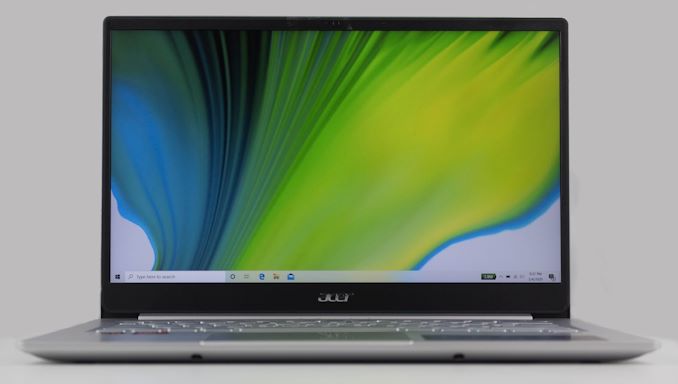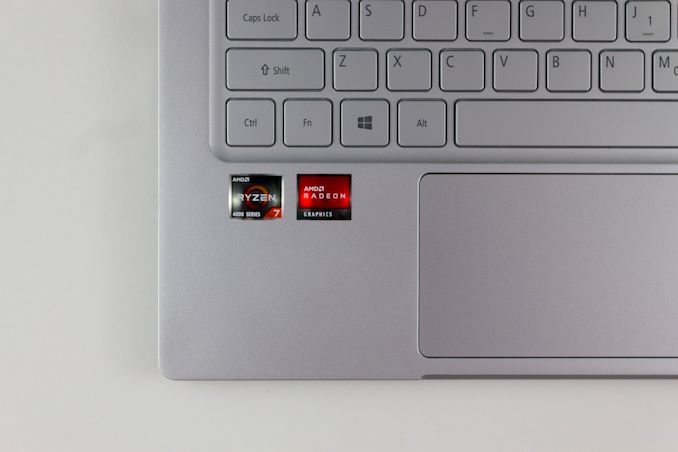The Acer Swift 3 SF314 Notebook Review: Swift Gets Swifter With Ryzen 4000
by Brett Howse & Andrei Frumusanu on May 5, 2020 8:00 AM EST
Almost two years ago to the day, we had a chance to check out Acer’s Swift 3 laptop featuring AMD's first Ryzen Mobile platform, Raven Ridge. Acer has been a strong partner for AMD, generally being one of the first out of the gate with new designs featuring AMD’s latest platforms, and this year that partnership has played out again. Today we are taking a look at the newest AMD APU offering, the Ryzen 4000 "Renoir", which is at the heart of Acer’s latest iteration of the 14-inch Swift 3. With a brand-new AMD processor and some innovations in the Swift 3 design itself, both AMD and Acer have made some tremendous improvements for 2020.
Ryzen 7 4700U
The big news for 2020 is AMD’s new APU platform, codenamed Renoir. Selling as the Ryzen 4000 series, these new APUs bring a number of major updates to AMD's platform, as the company further sands down the rough edges from the Ryzen 3000 Picasso series. Key to this is a much-needed jump from GlobalFoundries' 12nm process to TSMC's class-leading 7nm process, giving AMD a much-wanted boost in transistor performance and overall energy efficiency. Coupled with a number of further optimizations at the chip and driver level, and AMD's latest APUs are proving far better suited for thin-and-light mobile designs than their predecessors.
Under the hood, like AMD's desktop processors introduced last year, the new Ryzen 4000 series APUs are the first laptop-focused products from AMD which feature their Zen 2 CPU cores. Designed hand-in-hand with TSMC's 7nm process, the Zen 2 architecture has further boosted AMD's performance across both IPC and clockspeeds, and the small cores have allowed AMD to get away with 8 of them in even a laptop APU. Meanwhile the iGPU is based on the same Vega architecture graphics as both the 2000-series and 3000-series APUs, but in a new configuration. Thanks to TSMC’s 7nm process, AMD has been able to crank up the GPU frequency much higher than before – so much higher that they’ve actually scaled back on the number of GPU compute units, while still promising improved GPU performance over the previous generation of APUs.
Ian had a chance to take the new Ryzen 4000 platform for a spin in early April, although that sample was the 45-Watt H series. Many of the concepts carry across though, so if you’ve not yet had a chance to catch up on Renoir, be sure to check out the Ryzen 9 4900HS review. The 45-Watt processor range is pretty much the standard in high-performance notebooks, but the vast majority of laptops on the market stick to the lower-powered 15-Watt range, which is what we have in the Acer Swift 3.
Acer has opted for what is likely to be one of the most popular SKUs in the AMD Ryzen 4000 range, the Ryzen 7 4700U. AMD has gone a very non-traditional route for this part, offering eight physical CPU cores, but disabling simultaneous multithreading (SMT). All of AMD’s H-Series lineup of 45-Watt processors do offer SMT, but only two of the new U-Series provide this, with the Ryzen 5 4600U offering 6 cores and 12 threads, and the Ryzen 7 4800U providing 8 cores and 16 threads, all in the 15-Watt thermal design power (TDP) that is so common on laptops. In the typical 15-Watt laptop space, AMD is the first to offer 8 cores, just not always with SMT.
On the GPU side, the Ryzen 7 4700U offers 7 Vega-architecture Compute Units (CUs), with a maximum clockspeed of 1600 MHz. Compared to the previous generation Ryzen 7 3700U, the GPU drops three compute units, but bumps the maximum frequency from 1300 MHz to 1600 MHz, so we shall see where this plays out in terms of performance.
The Acer Swift 3
Acer has managed to bundle a lot of product into the Swift 3. The 14-inch notebook features a 1920x1080 IPS display that, albeit lacking touch support, does get showcased well thanks to the Swift 3's thin bezel surround. The laptop ships with 8 GB of DDR4-3200, and though we would have loved to see LPDDR4X, the capacity is what is important here, and 8 GB is a good amount for a budget-friendly laptop like the Swift 3. Also, Acer has managed to outfit this notebook with a 512 GB SSD, which is fantastic. They will also be offering a less-expensive version with a Ryzen 5 4500U, 8 GB of RAM, and a 256 GB SSD.
| Acer Swift 3 SF314-42 | |||||
| Ryzen 5 | Ryzen 7 Model Reviewed |
||||
| CPU | AMD Ryzen 5 4500U 6 core 6 thread 2.3-4.0 GHz 2x 4MB L3 15W TDP |
AMD Ryzen 7 4700U 8 core 8 thread 2.0-4.1 GHz 2x 4MB L3 15W TDP |
|||
| GPU | AMD Vega 6 6 CUs 1500MHz Boost |
AMD Vega 7 7 CUs 1600MHz Boost |
|||
| RAM | 8 GB Dual-Channel DDR4-3200 | ||||
| Storage | 256 GB PCIe NVMe SSD | 512 GB PCIe NVMe SSD | |||
| Display | 14-inch 1920x1080 IPS | ||||
| Networking | Intel Wi-Fi 6 AX200 2x2:2 802.11ax Bluetooth 5.0 |
||||
| Audio | Stereo Speakers DTS Sound |
||||
| Battery | 48 Wh Li-Ion 65-Watt Charger (barrel connector) USB Power Delivery Support |
||||
| Right Side | USB 2.0 x 1 Headset jack Battery Charge Indicator |
||||
| Left Side | USB 3.2 Gen 1 x 1 with power-off charging USB 3.2 Gen 2 Type-C w/DisplayPort, PD HDMI 2.0 Charging connector |
||||
| Dimensions | 323.4 x 218.9 x 15.95 mm 12.73 x 8.62 x 0.63 inches |
||||
| Weight | 1.2 kg / 2.65 lbs | ||||
| Camera | 720p Super High Dynamic Range | ||||
| Extras | Fingerprint Reader | ||||
| Price (MSRP) | $629 USD | $649 USD | |||
Despite the strong APU, RAM, and storage offerings, Acer is not done there. The Swift 3 also features Wi-Fi 6 thanks to Intel’s AX200 wireless adapter, which means 2.4/5.0 GHz wireless support with 160 Mhz channels if your router is has the correct capabilities. There’s also an integrated fingerprint reader for Windows Hello Support, and the entire package is contained in an all-aluminum chassis which weighs just 1.2 kg / 2.65 lbs. Considering the $649 MSRP, this is an incredible value.











191 Comments
View All Comments
neblogai - Tuesday, May 5, 2020 - link
If you are interested in such things- check this video about the same laptop: https://youtu.be/awPI4RzKMvY?t=386 (use autotranslate). Basically- he put a thermal pads on the heatpipe so it transfers heat to the aluminum back cover. This allowed higher Cinebench result from cold and also higher and more consistent results in Cinebench loop. Before this modification- two of the 30 CB results were ~10% and 7% lower than others (4:40), while after the modding- all scores were higher, and without drops. Also- with this modification, bottom obviously got warmer, so this is not a solution for everyone.eastcoast_pete - Tuesday, May 5, 2020 - link
Thanks, that is an interesting review and modification. As you stated, the reviewer mentioned (assuming I can trust Google translate of the captioning) that this simple addition of thermal pads reduced the erratic thermal throttling a lot, and how little it would add to the BOM costs. Too bad Acer hasn't taken him up on his suggestion! I would pay an extra $5 for that; it's well worth it.anonomouse - Tuesday, May 5, 2020 - link
Any chance of memory latency and memory bandwidth comparison charts between the machines used in the SPEC2017 page? Would be interesting/useful to see these charts taking into account the performance on memory bound workloads, even if the Ice Lake part is using LPDDR4 and not DDR4 like the other two.wordlv - Tuesday, May 5, 2020 - link
Xps 13 runs @25w. This is known fact!hanselltc - Tuesday, May 5, 2020 - link
What the hell is the laptop doing with its thermal management? The SoC Temp FC5 just doesn't match up with the wattage it is drinking. Is the fan curve bad? Does the chip just flips out when it needs to balance CPU and iGPU powerdraw while it is hovering around the hard throttle temp limit?eastcoast_pete - Tuesday, May 5, 2020 - link
I found that link posted by neblogai a few comments up really informative! Apparently, Acer left a lot of potential, yet straightforward heat dissipation on the table.Hulk - Tuesday, May 5, 2020 - link
AMD is obviously on a roll but looking at these Ice Lake results I'd say Intel ain't dead yet. We have a fight on our hands!watzupken - Wednesday, May 6, 2020 - link
"AMD is obviously on a roll but looking at these Ice Lake results I'd say Intel ain't dead yet. We have a fight on our hands!"Firstly, I don't think it is a good comparison between a top end laptop running the top end Intel Ice Lake chip, and this low end Swift 3, running a mid high end Renoir chip. Top end laptops normally put in more care when it comes to cooling, and I believe this Dell model may be using a dual fan cooling solution despite its small and slim size. The cooling will certainly help improve sustained and burst performance, which in turn affect the benchmark scores. From my experience, Acer Swift 3 typically employs a single fan, single heatpipe cooling solution, which is woefully poor in cooling. If you look at some reviews out there on Ice Lake performance on lower end laptops, you noticed that the sustained clockspeed can go below 2Ghz, which will certainly hurt performance.
Secondly spec wise, the i7 and faster RAMs on the Dell will also give it an edge, against the Ryzen 7 4700U with slower RAM.
In this case, just as the review pointed out in the thermal section, I feel the Ryzen 7 4700U is actually very thermally limited to show its full potential. Hopefully we see other PC makers/ models that will provide better cooling.
Oxford Guy - Thursday, May 7, 2020 - link
Yes, if you limit the AMD chip to 8 watts:"The laptop really struggled with its thermals, dropping the framerate into single digits often. The device attempted to run at around 18 Watts of power draw, slightly over the 15 Watt TDP, but in fact only averaged around 8 Watts during this run."
supdawgwtfd - Tuesday, May 5, 2020 - link
"channels if your router is has the correct capabilities."Wanted! Proof reader/editor.